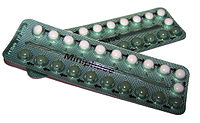
Photo from wikipedia
Background: The association between oral nutritional supplement use and nutritional parameters among patients with nondialysis chronic kidney disease (CKD-ND) with or at high risk of undernutrition/protein-energy wasting has not been… Click to show full abstract
Background: The association between oral nutritional supplement use and nutritional parameters among patients with nondialysis chronic kidney disease (CKD-ND) with or at high risk of undernutrition/protein-energy wasting has not been previously studied. The definition of patient subgroups most likely to benefit from oral nutritional supplementation (ONS) is also an area where more research is needed. Objective: To assess nutritional parameter trajectories among patients with CKD-ND prescribed oral nutritional supplements in British Columbia, and to compare trajectories by nutritional phenotype. Design: Longitudinal cohort study, pre-post design. Setting: Multidisciplinary CKD clinics across British Columbia. Patients: A total of 3957 adult patients with CKD-ND, who entered multidisciplinary CKD clinics during 2010 to 2019, met criteria for oral nutritional supplement prescription based on dietitian assessment, and received ≥1 oral nutritional supplement prescription. Measurements: Longitudinal nutritional parameters, including body mass index (BMI), serum albumin, serum bicarbonate, serum phosphate, and neutrophil-to-lymphocyte ratio (NLR). Methods: Using linear mixed models, slopes for nutritional and inflammation parameters were assessed in the 2-year periods before and after the first oral nutritional supplement prescription. Hierarchical cluster analysis was applied to identify nutritional phenotypes using baseline data, and slope analysis was repeated by cluster. Results: In the pre-oral-nutritional-supplement period, declines in BMI (−0.87 kg/m2/year, 95% confidence interval [CI]: −0.99 to −0.75), albumin (−1.11 g/L/year, 95% CI: −1.27 to −0.95), and bicarbonate (−0.49 mmol/L/year; 95% CI: −0.59 to −0.39), and increases in NLR (+0.79/year; 95% CI: 0.60 to 0.98) and phosphate (+0.05 mmol/L/year; 95% CI: 0.04 to 0.06) were observed. Following oral nutritional supplement prescription, there were statistically significant increases in BMI slope (+0.91 kg/m2/year, P < .0001), albumin slope (+0.82 g/L/year, P < .0001), and phosphate slope (+0.02 mmol/L/year, P = .005), as well as a decline in NLR slope of −0.55/year (P < .0001). There was no significant change in bicarbonate slope. Cluster analysis identified 5 distinct phenotypes. The cluster with the highest mean baseline NLR and lowest mean BMI demonstrated the greatest number of improvements in nutritional parameter slopes in the post-oral-nutritional-supplement period. Limitations: Possibility of residual confounding. Data on dietary intake, muscle mass, and nutritional scoring systems were not available in the registry. Conclusions: Among patients with CKD-ND prescribed oral nutritional supplements, there were improvements in nutrition/inflammation parameters over time following the first ONS prescription. The heterogeneity in response to ONS by cluster subgroup suggests an individualized approach to nutritional management may be beneficial.
Journal Title: Canadian Journal of Kidney Health and Disease
Year Published: 2022
Link to full text (if available)
Share on Social Media: Sign Up to like & get
recommendations!